Figgy adventures
August 29, 2025 • No Comments
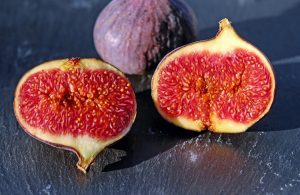 With all the back to school vibes around, I began to wonder what the experience was like for kids in the time of the Hellion House books, or at least the Victorian era. There were differences in curriculum, but the experience of leaving summer freedom behind for the drudgery of the classroom would be consistent. No doubt back to school was woe and excitement in equal measure then as now.
With all the back to school vibes around, I began to wonder what the experience was like for kids in the time of the Hellion House books, or at least the Victorian era. There were differences in curriculum, but the experience of leaving summer freedom behind for the drudgery of the classroom would be consistent. No doubt back to school was woe and excitement in equal measure then as now.
Not surprisingly, the details of the experience depended a lot on who you were. There were boarding schools and day schools, and arrangements around meals provided by the school varied, especially between the economic brackets of the attendees. I did a little investigation into the kind of desserts/puddings kids would get (any excuse to research old recipes). There were intriguing names, such as “spotted dick” and “roly-poly.” They tended to be starchy and filling, with preserves or dried fruit as the primary interest. This makes sense, because a) children are bottomless pits b) the dishes could be cheaply produced in bulk and c) preserved fruit made sense in an era without reliable refrigeration and a still-evolving network of rapid long-distance travel.
Currants and raisins were the most common fruit in the recipes I found. Another staple was dried figs, which tended to appear on more upper-class menus. This interested me as I had a bag of dried figs and no idea what to do with them. In the spirit of deep research (and fridge cleaning) I looked around for period options and their modern equivalents to concoct an enjoyable, historically-adjacent treat. I ignored the figgy pudding of Christmas carol fame because where, o where, is my pudding basin? and also it’s still too warm for any dish I need to douse in alcohol and set on fire.
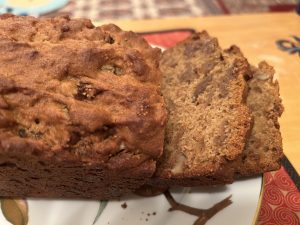 Happily there were plenty of non-flammable options. The first effort out of the oven was an apple and fig tart. It had some interesting features, including a layer of ground almonds at the bottom of the pie to soak up a yummy maple syrup sauce. Though promising, it wasn’t quite a five-star result. I like my pie fillings ooey-gooey and this was too dry and under-stuffed. Different apples and changing up the proportions would be necessary to make a properly sinful filling. I will give this one another go.
Happily there were plenty of non-flammable options. The first effort out of the oven was an apple and fig tart. It had some interesting features, including a layer of ground almonds at the bottom of the pie to soak up a yummy maple syrup sauce. Though promising, it wasn’t quite a five-star result. I like my pie fillings ooey-gooey and this was too dry and under-stuffed. Different apples and changing up the proportions would be necessary to make a properly sinful filling. I will give this one another go.
The second option I’m happy to share because it is a nicely-textured loaf that tastes like autumn. It rose well, has a moist crumb, and properly balances the sweet and spicy elements. This recipe soaks the dried figs in black tea to soften them, which imparts a faintly smoky taste that pairs beautifully with the other seasonings. I highly recommend grating the nutmeg fresh for maximum pop. I could see the students at the University of Londria wrapping a slice in a napkin to eat while they bolted to their next class.
Here’s the recipe for that one. Pro tip: be sure to cut the woody stems out of the figs
Preheat oven to 350F
Sift:
1.5 cups of flour
1 tsp baking powder
1/2 tsp baking soda
1/2 tsp cinnamon
1/2 tsp nutmeg (grated fresh)
Cream:
1/2 cup butter
2/3 cup brown sugar
Add: 3 eggs and 1 tsp vanilla
Then add the dry ingredients a bit at a time, along with:
1.5 cups of dried figs, chopped and soaked in very hot black tea for a half hour (then drain before adding to recipe)
1/2 cup chopped walnuts
Pour into a greased loaf tin and bake for 50 minutes
Cool on a wire rack before slicing.
Enjoy!
Price of Admission
July 14, 2025 • No Comments
 (From the story universe of Hellion House)
(From the story universe of Hellion House)
To prospective students at the University of Londria:
Thank you so much for expressing interest in attending our institution. We are more than delighted to escort you on a guided tour of the campus on Tuesday next.
Please note: since the fall of the Citadel and withdrawal of protection by the Conclave, there are changes in campus policy and practice. The tour will begin at three o’clock sharp. Please be punctual so that the tour, which is expected to take two hours, may commence and therefore conclude well before sunset. Those more than ten minutes late will be dropped from the guest list.
All college gates are closed and locked at dusk for security. Visitors are advised to clear the grounds before that time. Furthermore, visitors are encouraged to plan for emergencies, specifically defense against the Unseen. The University of Londria is not responsible for incidents of a predatory nature, so please arm accordingly.
This tour will be conducted on foot. Ladies are encouraged to dress in footwear suitable for running.
Yours most sincerely,
Bertram Miles, Esq.
Assistant Dean of Admissions
The Univeristy
The existence of Londria’s university arose organically out of the earliest books. As soon as Olivia Fletcher existed, so did her academic aspirations and therefore an institution where she could realize them.
This is a departure from the typical Victorian milieu, where the female of the species exists to cast a warm, fuzzy glow at the heart of the home and occasionally die of consumption (artistically, of course). Londria is under siege by monsters, and therefore women share in the work of survival, regardless of class.
That said, there is still pressure, in the uppermost income bracket, to devote oneself to the role of society wife. This may include promoting familial advancement through marriage, arranging salons, and designing witty canapes, which does constitute a full-time occupation even without the demands of social media. Nevertheless, everyone starts out with an education aimed toward a paid occupation. An individual with sufficient means and intelligence would attend university. For those without means but with outstanding brains, scholarships are available.
As humans rely on technology (and magic) to keep the Unseen from devouring all and sundry, the study of science and engineering receives the most attention. After all, someone has to design all those clever ray guns. Yes, there are faculties of literature and fine art, although they enjoy less emphasis. Humanity differentiates itself by the stories it tells itself and the beauty it creates, but not getting eaten is still top of the to-do list.
Campus
The university’s original buildings are old, built before the Great Disaster that occurred in late Tudor times. Clever observers recorded that was the moment everything went dreadfully awry, mostly due to dragons and other hungry monsters, and building programs were diverted to making a great big wall. Civic buildings took a back seat. Ergo, the core of the campus is medieval, much like Oxford or Cambridge, but smaller.
As Londria is a walled city, real estate is at a premium and the university aims to support itself with kitchen and rooftop gardens wherever they can be accommodated. There are limited open lawns and playing fields, and what exists is multi-purpose and carefully scheduled to maximize access. However, the span of the river safely within the city walls is popular for boating, and there is a very popular rowing club dedicated to mayhem and occasional water sports.
Buildings adjacent to the university were absorbed as the student population expanded, but with resources at a premium very little was torn down and rebuilt. One exception is purpose-built residences on site for students. In addition, faculty might reside in town or have rooms on campus. Olivia’s professors reside in Starling Hall, with their personal quarters attached to the study where they tutor students.
There is, of course, a main library as well as faculty-specific collections. However, given the cost of producing and shipping books in general, the libraries do not lend out their treasures freely. Most required reading happens on-site.
Student Life
University is (in general) the time for many young people to find mentors, lovers, and their first defining pratfalls and victories. For Olivia, the highly competitive Faculty of Mathematics offers her the environment she likes best – structured, rational, and with clear markers of achievement and hierarchy. She knows where she fits in. For the first time, she has a serious suitor and a set of friends that is uniquely her own. She exists beyond her siblings and her home.
Sadly, in Queen’s Tide, that precious structure is shattered and her inner resources are tested because, well, the plot requires blood. Authors are horrible. Readers are ravening beasts demanding trial and tribulation in the name of entertainment.
There will be a fictional characters’ union meeting shortly after the university tour, assuming anyone survives.
A Witch’s Garden
May 24, 2025 • No Comments
 This is one of those topics that comes with caveats because, I am sure, a witch’s garden is whatever the witch wants it to be. Gardens are reflective of their caretaker’s personalities and therefore as unique as each individual and purpose. And, as with a witch’s cat, a witch’s garden (any garden, really) will have its own agenda.
This is one of those topics that comes with caveats because, I am sure, a witch’s garden is whatever the witch wants it to be. Gardens are reflective of their caretaker’s personalities and therefore as unique as each individual and purpose. And, as with a witch’s cat, a witch’s garden (any garden, really) will have its own agenda.
The Basics
That said, there will be guiding principles. In traditional folklore, witches lived in an agrarian setting, either as part of a community or adjacent to it. It stands to reason that, whatever else the witch was up to, they most likely planted a kitchen garden: herbs, vegetables and, if they were fortunate, a few fruit trees. There were likely some pretty flowers to attract pollinators and ensure a fruitful harvest.
Does that sound disappointingly mundane? It shouldn’t. Just because plants are well-known to us, don’t assume they are without enchantment. Apples have long association with myth and magic—from Snow White to Avalon, they are the go-to item in the fairy tale produce aisle. Helen of Troy might have been the face that launched a thousand ships, but it was the prize of a golden apple that started it all.
Sadly, I’m short of heroic legends featuring kale.
Medicinal Gardens
It’s fairly well-established that historically witches tended to be older single women with opinions and, more notably, land and fortunes the male elders felt would be better off in other hands. Say, their hands. As part of the property transfer process, these troublesome females were accused of concocting poisons, curses, and spells. Noxious herbs were prominently featured.
A knowledge of healing herbs was part of any housewife’s toolkit. They would be grown or gathered in season and preserved for future uses. What those herbs were varied depending on local practice, but a few are easily identified. Eyebright, for instance, is easy to use for making an eyewash effective for seasonal allergies. Heart’s ease, also known as wild pansy, has been used since the Middle Ages for cardiovascular and autoimmune issues. These plants were used so widely they were named for their healing properties.
Danger Gardens
What can cure, can kill. Plants are at the front of this line. An easy example is digitalis, or foxglove. While it’s the basis of an effective medication, it features in dozens of mystery novels as the heart-attack-inducing herbal slipped into a victim’s tea. Similarly, the right kind of eucalyptus infused in honey is a great cough syrup. The wrong kind is only good for koala bears. Even common culinary herbs, like thyme, can have adverse health effects in the wrong doses.
This is the territory of the Hollywood witch’s garden. Or, in more of a real-life setting, the Alnwick Poison Garden. On the surface, it might look fairly ordinary—mandrake is highly poisonous, but is just another bushy green thing to the untrained eye. Whether a curse or a cure, who needs magic when botany can do the heavy lifting?
To understand how to prepare and deploy the garden residents is the practitioner’s true power. A well-tended plant is very willing to show just how capable it can be. It’s only sensible to be cautious and very, very polite to whatever witches, fairies, or other garden keepers are about.
Magic Gardens
While gardens can feed, cure, or kill us, is there room for a magical element that would set a witch’s garden apart? Yes, I’m sure there is. I’ve been to gardens that felt special in a way that’s impossible to describe. I was taught as a child to leave a corner of the garden wild for the nature spirits, so maybe that makes the difference. The best words I have for those gardens with a little extra is harmony. They’re functioning as an energetic whole instead of a collection of manicured parts.
The witches in my books don’t always have gardens like the Carvers in the Dark Forgotten series do—some do live in apartments—but they do have an understanding of the energies that guide the botanical world. Healing is about restoring nature’s design. Evil is disrupting it. Vampires are in some ways outside nature—they have stepped beyond the norm into a kind of suspended state.
What kind of gardens would vampires have? I found this post from the National Garden Bureau on goth gardens. I’m enchanted by the blenderized concoction of yogurt and moss that can be painted onto objects to encourage insta-mossy hardscaping.
Hungary Water: Part 2
March 21, 2022 • 3 Comments
This is the continuation of this  blog describing the recipe and my first try at recreating Hungary Water. I left the test batches to steep for about three months. I waited some months more to let the scents settle down and blend.
blog describing the recipe and my first try at recreating Hungary Water. I left the test batches to steep for about three months. I waited some months more to let the scents settle down and blend.
My first observation is that volume is important. By the time I strained the vegetable matter from my test batches, I didn’t get much yield—maybe half a cup per jar. The results were also very concentrated. When I do this again, I’m going to use at least a quart-sized container and more liquid.
The rosemary scent dominates the results, but that could be because it was the one element that was home grown and therefore freshest. All three bases initially overpowered the scent of the herbs but calmed down with time. The witch hazel version was fairly raunchy when it first brewed but is now the most pleasant of the three. It is a nice addition to a bath and as a facial astringent. I used the cider vinegar version (diluted) to rinse my hair after shampooing it. This is an excellent way to add scent and shine, but please be careful with color-treated hair as the vinegar can be drying. The vodka version was my least favorite. It killed some stubborn weeds in the driveway and probably any other living entity within five yards. I’m pretty sure the driveway glows after dark and the raccoons are building a bomb shelter.
My honest assessment is that a) a greater liquid volume would create a better balance of scents, b) the combination of herbs could possibly be simplified, and c) I need to do more research into a good liquid base for this purpose. The witch hazel is acceptable, but I’d like to keep exploring.
Bottom line: this experiment opened the door to some interesting possibilities for more research and experimentation.
Love, Hate, and Severed Heads – the Secret Life of Basil
February 20, 2022 • 2 Comments
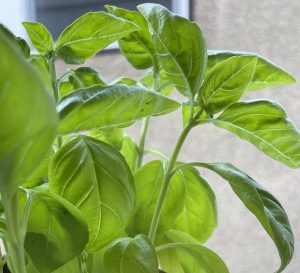 Many herbs have stories, and basil has more than most. The name derives from the Greek basileus, which means kingly or royal. Associated with love potions, angry monsters, and tales of romantic tragedy (and decapitation), basil’s legend goes far beyond pesto.
Many herbs have stories, and basil has more than most. The name derives from the Greek basileus, which means kingly or royal. Associated with love potions, angry monsters, and tales of romantic tragedy (and decapitation), basil’s legend goes far beyond pesto.
Basil is associated with the masculine, Mars, fire, and Scorpio. It is a culinary herb and also a strewing herb, valued for its scent. As an inhalant, it stimulates the intellect. As an incense, it invokes the presence of astral and mythological creatures and gives strength to pursue positive expansion, releasing fear associated with spiritual growth. Traditional health uses vary. It is used in folk medicine to treat fevers, and there is some investigation being done on treatment for herpes-related conditions like shingles.
Basil is used cosmetically for brightening the complexion. Sweet basil oil (Ocimum basilicum) is used in perfumes and also in a scalp massage to stimulate healthy hair growth.
According to the Ancient World—or at least the Greco-Roman segment thereof—basil was associated with anger and insanity. Perhaps this comes from its association with scorpions, salamanders, and also the basilisk, a dragon-esque creature that could kill with a glare. Given all the cranky crawlies, it’s a good thing basil was reputed to draw the poison from venomous bites.
It’s hard to say when the humble herb moved from angry lizards to love potions, but by the Middle Ages a sprig of basil became a love token and a means of attracting wealth. It was also said to have grown at the site of Christ’s crucifixion—further evidence of its ability to repel evil—and in some regions was planted on graves. In India, holy basil (Tulsi) is used for purification and protection.
Basil’s twin spirits of love and hate twine together in Giovanni Boccaccio’s Decameron, a 14th Century collection of Italian tales. Many know the story from John Keats’s  1818 poem retelling the story. In a nutshell (or herb pot), lovely young Isabella is destined for an advantageous marriage but falls in love with a handsome servant named Lorenzo. Furious, her brothers murder the young man. Guided by the ghost of her dead lover, Isabella digs up his body, chops off his head, and buries it in a pot of basil. There, she can water it with her tears and waste away in fine tragic fashion.
1818 poem retelling the story. In a nutshell (or herb pot), lovely young Isabella is destined for an advantageous marriage but falls in love with a handsome servant named Lorenzo. Furious, her brothers murder the young man. Guided by the ghost of her dead lover, Isabella digs up his body, chops off his head, and buries it in a pot of basil. There, she can water it with her tears and waste away in fine tragic fashion.
For such a grim tale, it inspired a wealth of lovely pre-Raphaelite art, like this painting by William Holman Hunt.
Common garden basil is native to India and flowers in high summer. I’ve never found basil easy to grow indoors. It loves heat, but not too much; rich soil, but not too much richness; and exactly the right amount of water. A bright windowsill is good, but be careful not to introduce other plants nearby. I had a thriving pot of globe basil until I left a planter of cat grass beside it just long enough to deposit a swarm of pesto-loving aphids. The best home-grown basil I ever saw lived in a compost box beneath a tent of plastic that kept the cold dew off the leaves. There, the plants grew to a Jurassic size I’ve never been able to replicate.
Check this blog for my pesto recipe.
IMPORTANT DISCLAIMER: herbal medicines should be prepared and taken under the supervision of a trained professional (and that does not include me or this blog).
References:
I consulted quite a few sources for this blog, but here are the main ones:
Easley, Thomas, and Steven Horne. The Modern Herbal Dispensatory. Berkeley, California: North Atlantic Books, 2016.
Beyerl, Paul. The Master Book of Herbalism. Blaine, Washington: Phoenix Publishing Inc., 1984.
Grieve, Mrs. M. A Modern Herbal. London: Tiger Books International, 1992.
Cunningham, Scott. Cunningham’s Encyclopedia of Magical Herbs, 2nd edition. Woodbury, Minnesota Llewellyn Publications, 2020.
Rose, Jeanne The Aromatherapy Book: Applications & Inhalations Berkeley, California, 1992
Ten Days in a Mad-House
July 26, 2021 • No Comments

 There aren’t many historical figures I want to fangirl over, but Nellie Bly (born Elizabeth Cochrane Seaman 1864 – 1922) makes the list. An American reporter, she pursued investigative stories at a time when women were doomed to penning fluff pieces. Bly soon tired of the society pages and insisted on challenging subjects. Danger was no deterrent – among other assignments, she covered the European Eastern Front during WWI.
There aren’t many historical figures I want to fangirl over, but Nellie Bly (born Elizabeth Cochrane Seaman 1864 – 1922) makes the list. An American reporter, she pursued investigative stories at a time when women were doomed to penning fluff pieces. Bly soon tired of the society pages and insisted on challenging subjects. Danger was no deterrent – among other assignments, she covered the European Eastern Front during WWI.
Around 2019, I read Ten Days in a Mad-House, Bly’s expose of the Women’s Lunatic Asylum on Blackwell’s Island. She got herself committed and posed as one of the female inmates to discover what went on inside. Needless to say, it wasn’t pretty. Her revelations of abusive living conditions and the casual cruelty of asylum officials shocked the New York public of 1887. Eventually, it led to reforms at the asylum. Her steady, detailed narrative stands up today as readable reporting.
I returned to Bly’s story in my research of Victorian-era asylums. When I learned there was a film adaptation, I quickly found it on Hoopla. Timothy Hines wrote and directed this 2015 production (10 Days in a Madhouse). Caroline Barry is charming as Nellie, but I question her chirpiness in places. And unfortunately, where the true story is dark enough, the movie gilds the lily in places. As a result, the tone comes out as spunky and sordid at the same time, making me wonder what audience they were aiming for.
That said, the movie worked well enough as a recap. The unsanitary conditions, bad food, inadequate heating, and casual cruelty are all part of the original. So is the maddening truth that institutions silenced the inconvenient far more often than they cured them.
Unruly women were deemed most inconvenient indeed.
DIY Historical Cosmetics: Queen of Hungary’s Water
April 26, 2021 • 3 Comments
 Queen of Hungary’s Water aka Hungary Water has been one of my favourite scents for as long as I’ve been wearing perfume. It’s herbal rather than sweet, with a clean, bright finish. Though no two blends are exactly the same, lemon and rosemary are usually the dominant notes. As I was making this up, the scent of the herbs was almost dizzying. It’s like a herb garden in a jar.
Queen of Hungary’s Water aka Hungary Water has been one of my favourite scents for as long as I’ve been wearing perfume. It’s herbal rather than sweet, with a clean, bright finish. Though no two blends are exactly the same, lemon and rosemary are usually the dominant notes. As I was making this up, the scent of the herbs was almost dizzying. It’s like a herb garden in a jar.
Some sources claim Queen of Hungary’s Water is the first alcohol-based perfume, or at least the first European one, and dates from the beginning of the fourteenth century. It’s also used as a skin tonic, the herbal ingredients effective against acne and eczema, among other issues. In addition, it can be used to bathe the temples to cure a headache. It is for external use only. Do not drink it or take it as a tincture.
Ingredients are important
There are a lot of different recipes for Hungary Water, but be careful. Beware of recipes that use lemon verbena as a main ingredient as the essential oil of that plant has been linked to sun sensitivity, which can increase the likelihood of sunburn. Lemon balm does not have the same problem.
Try to get organic herbs and essential oils if you can. Good quality dried herbs will store in a cool, dry place until it’s time to make another batch.
Recipe:
Layer the herbs in a wide mouth jar. A mason jar is ideal (bigger is better – the herbs swell once the liquid goes in).
2 tablespoons of lemon balm
2 tablespoons of lavender
2 tablespoons of calendula
2 tablespoons of rose petals
2 tablespoons of chamomile
1.5 tablespoons of comfrey
1 tablespoon of sage
1 tablespoon of rosemary
1 tablespoon of peppermint
1 tablespoon of elderflowers
12 drops of helichrysum oil
Top with chopped lemon peel (1/3 of a lemon rind, pith removed)
Cover the herbs with apple cider vinegar, witch hazel, or vodka. Allow for a couple inches of liquid above the herbs. Store for several weeks, shaking a couple of times a day.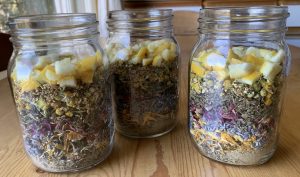
As this is my first time making this, I’ve done one each using the vinegar, witch hazel, and vodka to see which turns out best. Please see this blog for the results.
I based this recipe on several existing sources both in books and online, including this one, this one, and this one. I’ll adjust the ingredients as time goes on until I create my own preferred combination. For now, I’m sharing my experiment with you!
Post Script
Please note:
Yes, I am a writer of vampiric fiction, but before you get excited, dear reader, the Hungarian noble in question is not Elizabeth Bathory of “bathing in the blood of virgins” fame, nor does this post describe a bracing post-blood tonic or solution for that awful bathtub ring. I suggest a foaming cleanser with plenty of bleach for that.
Victorian Funeral Biscuits – the Recipe
• 2 Comments
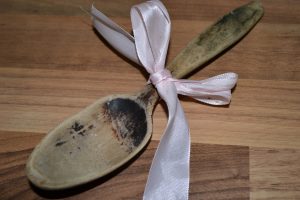 Funeral biscuits played a part the Victorian tradition of death and mourning. I cover their history in my previous post on the topic, and now we come to the recipe.
Funeral biscuits played a part the Victorian tradition of death and mourning. I cover their history in my previous post on the topic, and now we come to the recipe.
Sadly, it’s hard to know exactly what the biscuits tasted like. Even if they were available in a museum somewhere, I’m not like the Eating History guys and willing to nosh on decades-old treats. To make things more difficult, I could not find funeral biscuits in a cookbook I trusted. One recipe included modern ingredients and others were vague to the point of uselessness. So, I set out to invent something from those items that appeared in the majority of texts.
Consistent ingredients were flour, sugar, and caraway seed. I tested various combinations of other things, including icing sugar, milk, and cornstarch. Results varied from interesting charcoal to hard as a brick. When I did finally achieve a good result, I understood why rationing during wartime finally finished off the production of these biscuits–they’re no good without lashings of butter.
Victorian Funeral Biscuits
Preheat oven to 350 F
Cream: 1.5 cups of sugar with 1 cup of soft butter
Add: 1 tsp vanilla and 2 extra-large beaten eggs (or 3 smaller ones). Mix until smooth
Sift: 2.5 cups of flour, 2 tsp of cardamon, and 1/2 tsp salt. Add to wet ingredients a bit at a time along with a tablespoon of whole caraway seeds (some recipes recommend toasting these before adding them to the dough).
Mix until all wet ingredients are absorbed. The dough will be slightly sticky. If you wish to use a cookie stamp, chill for a few hours before going further. Otherwise, make a small ball and press with a fork to form the cookie. Keep rinsing the fork in cold water to keep it from sticking in the dough.
Bake on a greased cookie sheet for 12 minutes or until the bottom just begins to turn brown. (Do not overbake!) Cool slightly before moving to a wire rack. The result should be a crisp, slightly caramelized bottom with a softer top.
 As noted above, this recipe is only an estimation of what the original Victorian funeral biscuits might have been like. The quality of ingredients today is very different, as those of us who experienced “Buttergate” can attest. However, I think this is a reasonable approximation of the buttery, slightly spicy biscuit that’s perfect with tea after a brisk seaside stroll.
As noted above, this recipe is only an estimation of what the original Victorian funeral biscuits might have been like. The quality of ingredients today is very different, as those of us who experienced “Buttergate” can attest. However, I think this is a reasonable approximation of the buttery, slightly spicy biscuit that’s perfect with tea after a brisk seaside stroll.
Of Shortbread and Cannibalism
March 31, 2021 • 1 Comment
 Imagine a knock at the door and, when you answer, the caller hands you a package. It contains a wrapped packet of biscuits tied with a black ribbon. Instantly, you know there’s been a death, and this is your invitation to the funeral.
Imagine a knock at the door and, when you answer, the caller hands you a package. It contains a wrapped packet of biscuits tied with a black ribbon. Instantly, you know there’s been a death, and this is your invitation to the funeral.
A Victorian Funeral Tradition
Funeral biscuits flourished as part of the elaborate panoply of the Victorian funeral. References to them are found in England and parts of North America. Surviving recipes are rare, which suggests they might have been very simple or an adaptation of something most cooks already knew how to make.
Those recipes or descriptions that do exist suggest a sweet similar to shortbread or a molasses cookie. More elegant households favored a lighter sponge  similar to ladyfingers or Savoy biscuits. The shortbread style often bore a design such as an hourglass, heart, cross, skull, cupid or other symbolic image. The use of such stamps gives us a clue to the consistency of the dough in use.
similar to ladyfingers or Savoy biscuits. The shortbread style often bore a design such as an hourglass, heart, cross, skull, cupid or other symbolic image. The use of such stamps gives us a clue to the consistency of the dough in use.
The biscuits appeared at the funeral as an accompaniment to a restorative glass of sherry or port wine. Mourners or to those unable to attend received wrapped packages of biscuits. And, as mentioned above, they could also be used as an invitation.
Bakeries produced biscuits to order, especially for large funerals. Between two and six biscuits were bundled in waxed paper. Sometimes, this wrapping bore a design with the usual skulls, hearts, etc. since the Victorians were apparently Goths at heart. At other times, the paper displayed the death notice of the deceased, a poem, or a Bible verse (see an example here). Black wax or a black ribbon sealed the package. For this keepsake of the departed, presentation mattered.
Digression alert: There is an odd parallel with wedding cakes here. If you’re royal, cake mementos can persist down the centuries. For those craving a slice of Queen Victoria’s wedding cake, this article is for you.
 You Are Who You Eat
You Are Who You Eat
The funeral biscuit tradition faded with the advent of professional funeral parlors and the maelstrom of the World Wars, but its roots run deep in history. There is a connection between these tidy little biscuits and the the idea of claiming an energetic connection to the deceased.
Prior to the oh-so-hygienic funeral parlor, family members awaited burial in the home–in the parlor, if the house had such a room. Relatives, friends, and neighbors visited to pay their respects. According to folk tradition, objects belonging to or placed around the dead absorbed some of their qualities, and it was possible for the living to gain those qualities by possessing or consuming them. The same kind of sympathetic magic appears in Game of Thrones, when Daenerys consumes the heart of a stallion so that her child will have the horse’s strength. In both cases, a tangible (edible) medium transmits the deceased’s qualities to the living.
Neolithic funerals involved the occasional bit of cannibalism (several examples have been found in southern Iberia). In Central Europe during the Middle Ages, household bakers made “corpse cakes” (sometimes shaped like gingerbread men) from dough risen on the body. Mourners consumed the cakes to absorb the deceased’s virtues. In similar fashion, in Wales and the West Country of England, sin-eaters (usually someone at the bottom of the social scale) consumed bread and salt left on the body, thus absorbing the dead man’s guilt. In some accounts, villagers beat the sin-eater afterward to punish those transgressions.
There is a long and winding connection between corpse cakes and the Victorians’ polite shortbread marked with a skull. Nevertheless, given the nineteenth-century appetite for heavy symbolism, it’s likely at least some understood and accepted that grim association.
I did make an attempt at recreating funeral biscuits. Because this entry is already getting long, I will detail that adventure in another post.
Further Reading:
Frisby, Helen. Traditions of Death and Burial. Oxford, UK: Shire Publications, 2019.
Vervain: the Enchanter’s Plant
March 16, 2021 • 4 Comments
 Forget using stinky old garlic against vampires. The Vampire Diaries ushered in a new era of preternatural pest control with vervain, making a plot device from a relatively common herb long associated with warding off unwanted magic.
Forget using stinky old garlic against vampires. The Vampire Diaries ushered in a new era of preternatural pest control with vervain, making a plot device from a relatively common herb long associated with warding off unwanted magic.
Curiosity prompted me to take a closer look at this plant, and what I found piqued my interest—especially since I feature herbalists in my upcoming books. Who doesn’t like a useful research rabbit hole?
Common names
Alternate names for vervain include enchanter’s plant, herb of the cross, and Juno’s tears. Some legends claim druids used it to purify their ritual waters. Others say Romans used bundles of vervain to cleanse their altars.
The Romans also called vervain herba sacra, or the “divine weed.” They believed it could cure the bites of all rabid animals, arrest the progress of venom, cure the plague, and avert sorcery. They even held verbenalia, a feast in the plant’s honor. Another name for vervain was herba veneris, so called because of the aphrodisiac qualities ascribed to it by the Ancients (presumably also the Romans).
Lore has it that vervain grew on the Mount of Calvary, where the faithful used it to staunch the wounds of the Saviour. For this reason, “Herb of Grace” is another popular name for vervain, although this term is also applied to rue.
This is the difficulty with studying herbs—proper plant identification is everything. Common names are confusing and using the wrong plant (especially in medications) could be hazardous.
Speaking of nomenclature, A Modern Herbal says the name vervain possibly comes from the Celtic languages, fer meaning “to drive away” and faen meaning “stone.” The name might reflect the herb’s early use in treating bladder ailments.
There are two kinds of vervain
Blue Vervain (Verbena hastata) is known as American vervain or false vervain and is native to North America. It has medicinal properties, but they are different from European vervain (Verbena officinalis), which is the kind I’m writing about here.
Verbena officinalis hails from the Mediterranean region and has escaped gardens to run wild in North America. This perennial likes roadsides and sunny pastures. It has white or lilac spiky flowers that bloom from June to October. Its stems are quadrangular and branch. The leaves grow in opposite pairs. It has little scent and a slightly bitter taste. When harvesting, pick the plant before it flowers and dry it immediately. Typically this happens in July, though this could vary with climate.
Don’t confuse these members of the verbena family with lemon verbena, an altogether different (and delightful) plant.
Uses of Vervain
Modern herbalists use Verbena officinalis as a stimulant, astringent, diuretic, nerve tonic, and fever medication. They employ it in the treatment of skin ailments and for depression following illness. It can be used as a tea to calm nerves and promote sleep or in a mouthwash against gum disease.
IMPORTANT DISCLAIMER: herbal medicines should be prepared and taken under the supervision of a trained professional (and that does not include me or this blog).
But back to the paranormal stuff.
Magically (or Magickally, depending on your preference) speaking, vervain assists purification, protection, blessings, and communication with nature spirits. Ruled by Venus, vervain belongs to the earth element. A crown of vervain worn by the magician will protect against evil spirits. It is used in ritual incense for exorcism and in prosperity spells.
References
I never met an herbal dictionary I didn’t like, so I have a lot of them—some from when I was a teenager, some barely out the Amazon carton. I consulted quite a few books to put this post together, so this is just a short list of the main sources.
Beyerl, Paul. The Master Book of Herbalism. Blaine, Washington: Phoenix Publishing Inc., 1984.
Easley, Thomas, and Steven Horne. The Modern Herbal Dispensatory. Berkeley, California: North Atlantic Books, 2016.
Evans, Ivor H. Brewer’s Dictionary of Phrase and Fable, 14th edition. Markham, Ontario: Fitzhenry and Whiteside Limited, 1989.
Grieve, Mrs. M. A Modern Herbal. London: Tiger Books International, 1992.
Lust, John. The Herb Book. New York: Bantam, 1974.









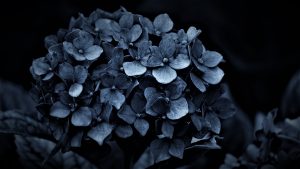 You Are Who You Eat
You Are Who You Eat
